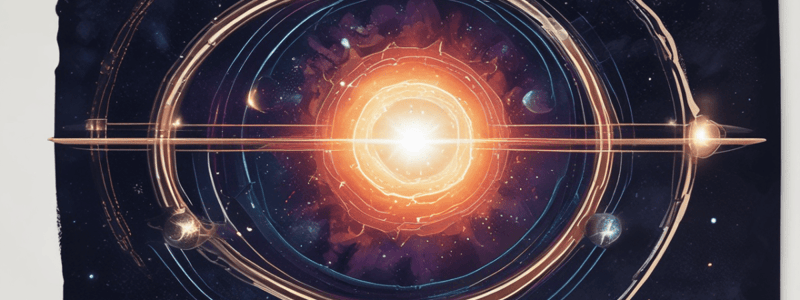Podcast
Questions and Answers
What occurs when a star's core contains mostly iron?
What occurs when a star's core contains mostly iron?
- Fusion in the core ceases. (correct)
- The core expands uncontrollably.
- Fusion intensifies significantly.
- The star begins to cool rapidly.
What is the temperature in the core just before a star explodes?
What is the temperature in the core just before a star explodes?
- 10 billion degrees
- 50 billion degrees
- 100 billion degrees (correct)
- 200 billion degrees
What happens to the matter of a star during a supernova explosion?
What happens to the matter of a star during a supernova explosion?
- It transforms into dark matter.
- It retains mass and cools down gradually.
- It is drawn back into the core.
- It is forced into space by a shock wave. (correct)
What remains after a supernova if the original star was not extremely large?
What remains after a supernova if the original star was not extremely large?
What occurs in the final phase of a star's collapse?
What occurs in the final phase of a star's collapse?
What determines whether a neutron star or a black hole forms after the supernova?
What determines whether a neutron star or a black hole forms after the supernova?
What characteristic defines a black hole after the core collapses?
What characteristic defines a black hole after the core collapses?
What does the term 'super-dense core' refer to following a supernova?
What does the term 'super-dense core' refer to following a supernova?
What primarily causes the forces acting upon the core of a collapsing star?
What primarily causes the forces acting upon the core of a collapsing star?
What is the end result for a massive star that undergoes a supernova?
What is the end result for a massive star that undergoes a supernova?
Which stage does a small-to-medium star enter after becoming a red giant?
Which stage does a small-to-medium star enter after becoming a red giant?
What triggers the supernova explosion in a massive star?
What triggers the supernova explosion in a massive star?
Which of the following is NOT a stage in the life cycle of an average star?
Which of the following is NOT a stage in the life cycle of an average star?
How does the mass of a star influence its life cycle?
How does the mass of a star influence its life cycle?
What is the typical evolution path for a star born in a solar nebula?
What is the typical evolution path for a star born in a solar nebula?
What happens to the core of a massive star before it goes supernova?
What happens to the core of a massive star before it goes supernova?
Which of the following stars is classified as a red supergiant?
Which of the following stars is classified as a red supergiant?
What leads to the spectacular nature of supernova explosions?
What leads to the spectacular nature of supernova explosions?
Flashcards are hidden until you start studying
Study Notes
Life Cycle of a Star
- A star begins its life in a solar nebula, a dense cloud of gas and dust.
- Stars follow two main life paths based on their mass: average stars or massive stars.
- Average stars develop into red giants, then into planetary nebulae, finally ending as white dwarfs.
- Massive stars evolve into red supergiants and culminate in a supernova, resulting in either a neutron star or a black hole.
- Notable examples of red supergiants include Betelgeuse and Antares.
Creation of a Supernova
- Supernovae occur in stars with a mass eight times greater than that of the sun.
- The explosion arises when fusion reactions cease due to the star exhausting its fuel.
- Without fusion, there is no outward pressure to counteract the gravitational pull, leading to core collapse.
- As the star's outer layers expand, the core contracts, heating and densifying until it primarily consists of iron.
- Fusion stops in the core when only iron is present, leading to a rapid collapse with core temperatures reaching over 100 billion degrees.
- The core’s collapse results in the star exploding, creating a shock wave that disperses stellar material into space.
Neutron Star and Black Hole
- After a supernova, remnants include a neutron star, which is an ultra-dense core primarily composed of neutrons.
- If the original star is exceedingly massive, neutron stars may collapse further to form black holes, regions in space with gravitational pulls so strong that even light cannot escape.
Studying That Suits You
Use AI to generate personalized quizzes and flashcards to suit your learning preferences.





